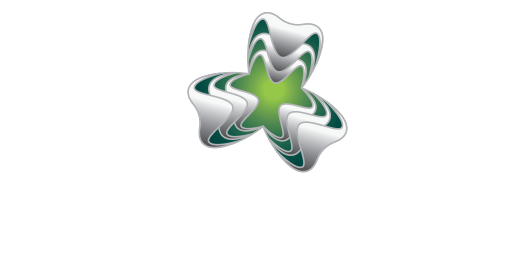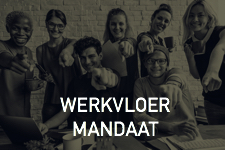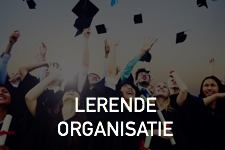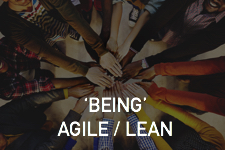Training & development
Development and change with a sustainable impact
For a training and development program to be sustainable, the type of learning offered is an essential consideration. Most people have already figured out, in their daily lives through their day-to-day experiences, what works and what doesn’t. The interaction with their environment helps determine whether a new mindset or behavior has a chance of sticking. And finally, people learn and change faster if it is something they want to do.
Development and Change – Important Points
- Use of varied and experience-oriented learning
- Inclusion of vital knowledge regarding people, cooperation and behavior
- Approach that includes multiple layers in the organisation (individual, team, & organisation layers)
- Appreciative Inquiry as methodology, and the use of positive psychology
Sustainable impact training
At every level in the organisation
Op álle niveaus in de organisatie
Ontwikkeling & Training
individu
-
Beschrijving
Wat drijft mensen? Daniel Pink gaf het al treffend aan, mensen worden gedreven door:- Purpose – Wat is het verschil dat jij wil maken als mens en als professional?
- Mastery – Wat vind je leuk en kan je goed?
- Autonomy – Waardoor laat jij je beperken – wat heb jij nodig?
In het ontwikkel traject ‘Vakmanschap in Actie’ ontdek je hoe je meer uit jouw vakmanschap kan halen. Hoe je met méér plezier méér impact kan maken. Hoe jij kan realiseren wat je belangrijk vindt en welke vrijheid je nodig hebt om te floreren.
De basis van het ontwikkeltraject is om als professional stil te staan en te herijken waar je staat: Wat vind ik belangrijk? Wat is het verschil dat ík wil maken? Waar ben ik goed in en wat vind ik ook leuk? Hoe vrij voel ik me/waardoor laat ik me beperken om dat te doen dat ik belangrijk vind?
Doelgroep
De doelgroepen voor Vakmanschap in Actie zijn:- Organisaties die willen investeren in de duurzame inzetbaarheid van hun mensen of dat nou binnen of buiten de eigen organisatie is;
- Organisaties die méér willen halen uit het vakmanschap van haar medewerkers en die de ruimte daarvoor ook willen geven;
- Organisaties die meer voor hun klanten willen bereiken door medewerkers die werken vanuit innerlijke drijfveren
-
Beschrijving
Er wordt van jou als expert verwacht dat jij het weet. Dat je met oplossingen komt. Dat je een plan hebt. Maar wat op die momenten dat je het eens níet weet? Tegen sommige mensen en op welke momenten kun je dat misschien wél zeggen – maar wanneer níet? En als van jou verwacht wordt dat je het weet, hoe gemakkelijk vraag en sta je open voor dan hulp? Hoe gemakkelijk is fouten maken voor je?En wat betekent dit voor hoeveel je zou kunnen leren? Hoe open ben je écht? In het ontwikkeltraject ‘De Complete Professional’ leer je om te gaan met de kanten van het expert-zijn die niet lijken te passen bij wat een expert is. Door die kanten bewust te integreren versterk je de basis van waaruit je als expert en als mens acteert.
Je kan vanuit je expert rol gemakkelijker schakelen naar niet weten, fouten maken, hulp vragen en ontvangen. Je bent effectiever in het samenwerken met anderen. Hierdoor bereik je ook gemakkelijker de juiste resultaten, met minder stress en met (nog) meer plezier.
Doelgroep
De doelgroepen voor ‘De Complete Professional’ zijn:- Professionals die de volgende stap willen maken in hun ontwikkeling en hun repertoire willen vergroten vanuit ‘wie ze zijn‘ in plaats van ‘iets anders te doen’;
- Senior professionals die aan hun duurzame inzetbaarheid willen werken
- Organisaties die de openheid om van elkaar te leren willen vergroten en leren tot een expliciete dagelijkse gewoonte willen maken.
-
Beschrijving
Wat drijft mensen? Net als het ontwikkeltraject’Vakmanschap in Actie’ zijn deze drijfveren het uitgangspunt, geïnspireerd op Daniel Pink:- Purpose – Wat Wat is het verschil dat jij wil maken als mens en als leidinggevende?
- Mastery – Wat vind je leuk en kan je goed?
- Autonomy – Waardoor laat jij je beperken? -Wat heb jij nodig?
Deze drijfveren gelden niet alleen voor jou als leidinggevende maar zijn ook relevant voor de mensen waar je leiding aan geeft.
In het ontwikkel traject ‘Leiderschap in Actie’ sta je als leidinggevende stil bij waar je staat: Wat vind ik belangrijk? Wat is het verschil dat ík wil maken? Waar ben ik goed in en wat vind ik ook leuk? Hoe vrij voel ik me/waardoor laat ik me beperken om dat te doen dat ik belangrijk vind?
Tegelijkertijd leer je jezelf beter kennen als leider. Hoeveel ruimte heb ik nodig en wat betekent dat voor de ruimte die ik mijn mensen geeft? Wat zijn míjn leidende principes? Werk ik vanuit gezag, vanuit macht of vanuit vertrouwen? Welke stijl van leiding geven past goed bij mij als authentiek persoon? Welke impact heb ik op andere mensen?
Doelgroep
De doelgroepen voor leiderschap in Actie zijn:- Leiders en managers die in zichzelf willen investeren en meer voldoening en energie uit hun leiderschap willen halen;
- Leiders en managers die geen ‘truukje’ willen leren maar willen leiden vanuit zichzelf als authentiek persoon;
- Organisaties die willen investeren in de duurzame inzetbaarheid van hun leidinggevenden, of dat nou binnen of buiten de eigen organisatie is;
- Organisaties die het belangrijk vinden leiderschap verder te ontwikkelen, afgestemd op de gewenste veranderingen in de organisatie;
Ontwikkeling & Training
team
-
Beschrijving
Samenwerken gaat om een relatie die we vaak niet zo goed kennen: de groepsrelatie.In de training worden de deelnemers bewust en vaardig op wat er valt waar te nemen in hun groepsrelatie. Ze worden zich bewust van wie zij zelf zijn in hun werkrelaties. Hoe kun je zowel gestalte geven aan je eigen ideeën en tegelijkertijd volledig collaboratief zijn? Vervolgens leren ze om de groepsrelatie te richten zodat die ondersteunend werkt voor het behalen van de doelen van het team.
Een belangrijke (interne) taak van een groep of team is het omarmen van de diversiteit in het team. Als gevolg daarvan ontstaat er ruimte voor het verzamelde vakmanschap en de ideeën en experimenten die helpen om de organisatie doelen te verwezenlijken.
De deelnemers leren in de training dagelijkse gewoontes waardoor ‘het beste uit het team’ halen geen zweverig maar praktisch en concrete aangelegenheid wordt.
Doelgroep
De doelgroepen voor Samenwerking in Actie – I zijn:- Professionele en Leiderschap teams die willen leren hoe ze met plezier het beste uit elkaar kunnen halen en samen datgene realiseren wat ze belangrijk vinden
- Organisaties die Agile of LEAN werken hebben ingevoerd, de volgende stap naar ‘being’ Agile / LEAN willen nemen door het verder ontwikkelen van de samenwerkings-cultuur
- Organisaties die expertise op samenwerken in de eigen organisatie willen borgen
- Organisaties het belangrijk vinden om gezamenlijk een herkenbare taal te gebruiken als het gaat over hoe men zich met elkaar relateert en interacteert
-
Beschrijving
‘Samenwerking in Actie – II’ bouwt voort op de principes uit ‘Samenwerking in Actie – I’ en gaat dieper in op wat er in de ‘onderstroom’ van samenwerken gebruikt.Dit ontwikkeltraject geeft handvaten voor het aangaan van succesvolle werk-relaties, ook als die nu moeilijk lopen. In een succesvolle relatie neem je ruimte om op te komen voor jouw ideeën en wat jíj belangrijk vindt. Tegelijkertijd weet je in te ‘tappen’ op de diversiteit die samenwerken met zich meebrengt waardoor betere en relevantere oplossingen tot stand komen.
In ‘Samenwerking in Actie – II’ leer je vloeiender te schakelen in complexere relaties, word je je bewuster van de neigingen die die complexiteit bij je oproepen en leer je wat helpt om vooruit te blijven gaan.
Doelgroep
De doelgroepen voor Samenwerking in Actie zijn:- Professionals die succesvol willen zijn in complexere werk relaties
- Organisaties die samenwerking wil ontwikkeling vanuit de authenticiteit en de eigen stijl van hun mensen
- Organisaties die Agile of LEAN werken hebben ingevoerd, de volgende stap naar ‘being’ Agile / LEAN willen nemen door het verder ontwikkelen van de samenwerkings-cultuur
Ontwikkeling & Training
organisatie
-
Beschrijving
Coachen beteken erop vertrouwen dat de ander zijn eigen oplossingen heeft. Maar misschien worden er fouten gemaakt. Fouten die jij als leidinggevende had kunnen vermijden. Want jij hebt eerder met dat bijltje gehakt. Het lijkt misschien op alles loslaten en passief vanaf de kant toekijken – maar is dat het echt?De deelnemers aan deze training leren op welke manier ze hun vakmensen zichzelf kunnen helpen om vooruit te komen. Ze leren als leidinggevende:
- Hoe je de focus kan verleggen van het behalen van inhoudelijk resultaat naar resultaat halen door de medewerkers te helpen om maximaal te leren;
- Wat de houding en mindset is van een coachende leidinggevende;
- Praktische manieren om een coachend gesprek aan te gaan;
- Te herkennen wanneer coachend leidinggeven niet effectief is of zal zijn;
- Bewustzijn te krijgen op wat de grens is als coach in de rol van leidinggevende
Doelgroep
De doelgroepen voor Coachend Leidinggeven zijn:
- Leiders ene managers die de wens hebben om minder instructief naar medewerkers te zijn en die in willen zetten op het vergroten van het leren van medewerkers
- Organisaties die ruimte willen geven aan het vakmanschap van medewerkers en de ideeën en initiatieven die daaruit voortkomen
- Organisaties die naar de cultuur van leren en groeien willen vergroten
-
Beschrijving
Je organisatie is gebaat bij betrokken medewerkers. Medewerkers die niet alleen komen om hun geld te verdienen, maar voor wie de betrokkenheid bij je organisatie op één of andere manier persoonlijk relevant is. En dat vergt wat anders dan alleen cognitief uitleggen wat de missie is en waarom die belangrijk is.In het ontwikkeltraject ‘Inspirerend leiderschap’ leer je het overbrengen van je boodschap verder te ontwikkelen en je communicatieve en relationele kwaliteiten breder in te zetten. Je leert en ervaart wat het is om een boodschap te vertellen met impact en om verbinding te maken met je publiek die werkt. Kortom, je leert wat het is om een inspirerend leider te zijn en op welke manier dat bij jou past.
Doelgroep
De doelgroepen voor ‘Inspirerend Leiderschap’ zijn:- Leiders en managers die meer invloed willen uitoefenen vanuit de betrokkenheid van medewerkers en daar ook in willen investeren;
- Leiders en managers die in zichzelf willen investeren en geen ‘truukjes’ willen leren maar willen inspirerend van binnenuit;
- Organisaties die de betrokkenheid van hun medewerkers willen vergroten;
- Organisaties die het belangrijk vinden om de organisatie missie ‘tot leven te brengen‘ om daarmee de kansen tot realiseren van de missie te vergroten.
Vergroting van ontwikkeling
Het effect van dit ontwikkeltraject wordt versterkt als de deelnemer een concrete en opportune context heeft in zijn huidige rol die gebruikt kan worden om Inspirerend Leiderschap te ontwikkelen. Verder wordt de ontwikkeling versterkt als deze doorlopen wordt met collega’s voor wie dezelfde context relevant is.
“What clients say”
“Wat klanten zeggen”
Jaro
Scrum Master – KPNOver hoe het zijn werk gemakkelijker maakt
‘Vanuit mijn rol als scrum master maakt deze training mijn werk gemakkelijker doordat we als team nu een gezamenlijk taal en kader hebben over de teamrelatie en onderlinge interactie. Hierdoor sturen we elkaar ter plekke bij als dat nodig is!’

Hazem Kallini
Ontwikkelaar – KPNOver de doelgroep voor deze trainingen
‘Elk type team waar teamleden willen begrijpen wat het betekent om een team te zijn. Daardoor veranderen ze niet alleen hun perspectief maar ook hun gedrag.’

Jasper van Maanen
Consultant – KPNOver gezamenlijke verantwoordelijkheid
‘Deze training heeft inzicht gegeven in wat dit team drijft. Het heeft ons het begrip gebracht dat wij als team zélf verantwoordelijk zijn voor waar we ons op kunnen verbeteren, en eigenaarschap moeten némen als we iets willen.’

Harish Sridhar
Lead Ontwikkelaar – KPNOver wat de training hem persoonlijk opleverde
‘De trainingen hebben me geholpen om beter te begrijpen en beter te zijn in effectieve communicatie en collaboratie. Ze hebben mijn gedachten rondom wat ik écht wil nieuw leven ingeblazen. Ik neem nu ook stappen om die te volgen.’

Martijn van Dijk
Ontwikkelaar – AccentureOver team ontwikkeling, beleefdheid en open zijn
‘Het team voelt als meer open, er is een veel hechtere band. Voorheen waren we nog erg beleefd naar elkaar toe.’

Nuria Munzel
Ontwikkelaar – KPNOver wat er veranderd is in het team
‘We communiceren nu veel opener én zijn heel expliciet in wat we willen als team!’

Bart Schaap
Agile Coach – AccentureOver verantwoordelijkheid nemen
‘Door de training ben ik me veel bewuster van waar ik wél verantwoordelijkheid kan nemen, ook al dacht ik eerst dat dat misschien maar 5% was…’

Hazem Kallini
Ontwikkelaar – KPNOver psychologische veiligheid
‘We zijn positiever dan ooit als een team. We zijn veel meer open naar elkaar en voelen ons veilig om onze gedachten te delen.’

Matthijs Schram
Technisch Lead – KPNOver hoe het hielp de teamband te versterken
‘Het onderling vertrouwen in het team is enorm gegroeid. Daarnaast hebben we nu duidelijke afspraken over wat we doen als er conflicten of irritaties opkomen. We houden niet meer terug en tegelijkertijd staan we veel meer open voor complimenten en feedback!’

Martijn van Dijk
Ontwikkelaar – AccentureOver gezamenlijke aspiratie
‘We hebben als team een stap gemaakt met grote impact door onze wérkelijke gezamenlijke aspiratie duidelijk te maken en daarvoor te gáán.’

Jaro
Scrum Master – KPNOver de snelheid van teamgroei
‘Ik ben positief verrast hoe waardevol een dergelijke training is voor versnelde treamgroei. Dit gaat sneller en effectiever dan enkel een leerproces via retro’s en korte sessies tussendoor. Èchte aandacht voor groei is essentieel.’

Matthijs Schram
Technisch Lead – KPNOver wat écht belangrijk is
‘De trainingen hebben me echt doen stilstaan bij wat ik uit het leven wil halen. Wat wil ik bereiken? Wat moet ik nu doen om daar te komen? Wat zijn nu echt mijn prioriteiten? Dit was heel waardevol voor mij.’

Jasper van Maanen
Consultant – KPNOver persoonlijke worsteling
‘Deze training me het ook moeilijk gemaakt. Is dit nu écht de baan die ik het leukste vind? Iets in me zegt dat ik daar nog goed over moet nadenken.’

Shanker Somanchi
Ontwikkelaar – KPNOver hoe hij de training heeft ervaren
‘Dit was een zeer waardevolle training voor mij. Het energie niveau vanaf de eerste tot en met de laatste dag was hoog. Het heeft me enorm geholpen.’

Harish Sridhar
Lead Ontwikkelaar – KPNOver het nemen van verantwoordelijkheid als een team
‘Ons bewustzijn, openheid, collaboratie en autonomie als team zijn vergroot. We nemen onze verantwoordelijkheid als we iets willen bereiken.’

Ivo Pels
Ontwikkelaar – KPNOver het belang van aandacht voor relatie
‘Één van de dingen die training me heeft doen beseffen is hoe belangrijk de relatie is om zaken voor elkaar te krijgen. Mensen/emoties zijn niet rationeel!’

Jasper van Maanen
Consultant – KPNOver wat de training hem bracht
‘De training was een groot feest van inzichten. Het heeft me echt geholpen om de andere teamleden goed te leren kennen en heeft diepgang gebracht in de onderlinge relatie.’

Hazem Kallini
Ontwikkelaar – KPNOver wat voor hem essentieel was
‘Het bewustzijn op de ‘giffen in team communicatie’ was essentieel voor mij. Het deed me realiseren dat als deze de team relatie gemakkelijk stukje bij beetje verslechterd. Het zijn sluipmoordenaars!’

Jaro
Scrum Master – KPNOver het belang van ‘gifvrije’ communicatie
‘Een mooi inzicht voor mij was het effect dat de ‘giffen in team communicatie’ hebben. Als team herkennen we het nu regelmatig en zijn we steeds beter in staat om te schakelen naar ‘gifvrij’.’

Harish Sridhar
Lead Ontwikkelaar – KPNOver de impact van de training
‘Ik heb mijn kwaliteiten weer omhelsd. De training heeft me verder geholpen om elkaar beter te leren kennen en begrijpen.’

Nuria Munzel
Ontwikkelaar – KPNOver het belang van het begrijpen van communicatie in teams
‘Het grootste ‘Aha!’ moment was voor het team toen we de ‘giffen in team communicatie’ doorleefd hadden. Op voorhand was ik me daar totaal niet van bewust!’

Matthijs Schram
Technisch Lead – KPNOver wat hij nu anders doet
‘Ik ben me veel bewuster van de samenhang met mijn omgeving en de teamleden. Dat helpt me om de meest optimale samenwerking te bereiken. Door de training heb ik nu veel meer tools en inzichten om dit goed te doen.’

Harish Sridhar
Lead Ontwikkelaar – KPNOver het zelf vaststellen van team ontwikkel doelen
‘De training en alle tools die we hebben gebruikt gaven ons waardevolle inzichten: Wat belangrijk is voor elk teamlid, hoe het werkt in ons team en wat de volgende stappen zijn in onze team ontwikkeling.’

Martijn van Dijk
Ontwikkelaar – AccentureOver persoonlijke ontwikkeling
‘De trainingen gaven mij een vollediger inzicht in mijzelf. Wat er gebeurt in mijn hoofd, waarom ik welke beslissingen neem en waarom ik ben wie ik ben.’

Nuria Munzel
Ontwikkelaar – KPNOver de doelgroep voor deze trainingen
‘Deze trainingen zijn essentieel voor elk type team, ongeacht de samenstelling.’

Jaro
Scrum Master – KPNOver hoe het zijn werk gemakkelijker maakt
‘Vanuit mijn rol als scrum master maakt deze training mijn werk gemakkelijker doordat we als team nu een gezamenlijk taal en kader hebben over de teamrelatie en onderlinge interactie. Hierdoor sturen we elkaar ter plekke bij als dat nodig is!’

Hazem Kallini
Ontwikkelaar – KPNOver de doelgroep voor deze trainingen
‘Elk type team waar teamleden willen begrijpen wat het betekent om een team te zijn. Daardoor veranderen ze niet alleen hun perspectief maar ook hun gedrag.’

Jasper van Maanen
Consultant – KPNOver gezamenlijke verantwoordelijkheid
‘Deze training heeft inzicht gegeven in wat dit team drijft. Het heeft ons het begrip gebracht dat wij als team zélf verantwoordelijk zijn voor waar we ons op kunnen verbeteren, en eigenaarschap moeten némen als we iets willen.’

Harish Sridhar
Lead Ontwikkelaar – KPNOver wat de training hem persoonlijk opleverde
‘De trainingen hebben me geholpen om beter te begrijpen en beter te zijn in effectieve communicatie en collaboratie. Ze hebben mijn gedachten rondom wat ik écht wil nieuw leven ingeblazen. Ik neem nu ook stappen om die te volgen.’

Martijn van Dijk
Ontwikkelaar – AccentureOver team ontwikkeling, beleefdheid en open zijn
‘Het team voelt als meer open, er is een veel hechtere band. Voorheen waren we nog erg beleefd naar elkaar toe.’

Nuria Munzel
Ontwikkelaar – KPNOver wat er veranderd is in het team
‘We communiceren nu veel opener én zijn heel expliciet in wat we willen als team!’

Bart Schaap
Agile Coach – AccentureOver verantwoordelijkheid nemen
‘Door de training ben ik me veel bewuster van waar ik wél verantwoordelijkheid kan nemen, ook al dacht ik eerst dat dat misschien maar 5% was…’

Hazem Kallini
Ontwikkelaar – KPNOver psychologische veiligheid
‘We zijn positiever dan ooit als een team. We zijn veel meer open naar elkaar en voelen ons veilig om onze gedachten te delen.’

Matthijs Schram
Technisch Lead – KPNOver hoe het hielp de teamband te versterken
‘Het onderling vertrouwen in het team is enorm gegroeid. Daarnaast hebben we nu duidelijke afspraken over wat we doen als er conflicten of irritaties opkomen. We houden niet meer terug en tegelijkertijd staan we veel meer open voor complimenten en feedback!’

Martijn van Dijk
Ontwikkelaar – AccentureOver gezamenlijke aspiratie
‘We hebben als team een stap gemaakt met grote impact door onze wérkelijke gezamenlijke aspiratie duidelijk te maken en daarvoor te gáán.’

Jaro
Scrum Master – KPNOver de snelheid van teamgroei
‘Ik ben positief verrast hoe waardevol een dergelijke training is voor versnelde treamgroei. Dit gaat sneller en effectiever dan enkel een leerproces via retro’s en korte sessies tussendoor. Èchte aandacht voor groei is essentieel.’

Matthijs Schram
Technisch Lead – KPNOver wat écht belangrijk is
‘De trainingen hebben me echt doen stilstaan bij wat ik uit het leven wil halen. Wat wil ik bereiken? Wat moet ik nu doen om daar te komen? Wat zijn nu echt mijn prioriteiten? Dit was heel waardevol voor mij.’

Jasper van Maanen
Consultant – KPNOver persoonlijke worsteling
‘Deze training me het ook moeilijk gemaakt. Is dit nu écht de baan die ik het leukste vind? Iets in me zegt dat ik daar nog goed over moet nadenken.’

Shanker Somanchi
Ontwikkelaar – KPNOver hoe hij de training heeft ervaren
‘Dit was een zeer waardevolle training voor mij. Het energie niveau vanaf de eerste tot en met de laatste dag was hoog. Het heeft me enorm geholpen.’

Harish Sridhar
Lead Ontwikkelaar – KPNOver het nemen van verantwoordelijkheid als een team
‘Ons bewustzijn, openheid, collaboratie en autonomie als team zijn vergroot. We nemen onze verantwoordelijkheid als we iets willen bereiken.’

Ivo Pels
Ontwikkelaar – KPNOver het belang van aandacht voor relatie
‘Één van de dingen die training me heeft doen beseffen is hoe belangrijk de relatie is om zaken voor elkaar te krijgen. Mensen/emoties zijn niet rationeel!’

Jasper van Maanen
Consultant – KPNOver wat de training hem bracht
‘De training was een groot feest van inzichten. Het heeft me echt geholpen om de andere teamleden goed te leren kennen en heeft diepgang gebracht in de onderlinge relatie.’

Hazem Kallini
Ontwikkelaar – KPNOver wat voor hem essentieel was
‘Het bewustzijn op de ‘giffen in team communicatie’ was essentieel voor mij. Het deed me realiseren dat als deze de team relatie gemakkelijk stukje bij beetje verslechterd. Het zijn sluipmoordenaars!’

Jaro
Scrum Master – KPNOver het belang van ‘gifvrije’ communicatie
‘Een mooi inzicht voor mij was het effect dat de ‘giffen in team communicatie’ hebben. Als team herkennen we het nu regelmatig en zijn we steeds beter in staat om te schakelen naar ‘gifvrij’.’

Harish Sridhar
Lead Ontwikkelaar – KPNOver de impact van de training
‘Ik heb mijn kwaliteiten weer omhelsd. De training heeft me verder geholpen om elkaar beter te leren kennen en begrijpen.’

Nuria Munzel
Ontwikkelaar – KPNOver het belang van het begrijpen van communicatie in teams
‘Het grootste ‘Aha!’ moment was voor het team toen we de ‘giffen in team communicatie’ doorleefd hadden. Op voorhand was ik me daar totaal niet van bewust!’

Matthijs Schram
Technisch Lead – KPNOver wat hij nu anders doet
‘Ik ben me veel bewuster van de samenhang met mijn omgeving en de teamleden. Dat helpt me om de meest optimale samenwerking te bereiken. Door de training heb ik nu veel meer tools en inzichten om dit goed te doen.’

Harish Sridhar
Lead Ontwikkelaar – KPNOver het zelf vaststellen van team ontwikkel doelen
‘De training en alle tools die we hebben gebruikt gaven ons waardevolle inzichten: Wat belangrijk is voor elk teamlid, hoe het werkt in ons team en wat de volgende stappen zijn in onze team ontwikkeling.’

Martijn van Dijk
Ontwikkelaar – AccentureOver persoonlijke ontwikkeling
‘De trainingen gaven mij een vollediger inzicht in mijzelf. Wat er gebeurt in mijn hoofd, waarom ik welke beslissingen neem en waarom ik ben wie ik ben.’

Nuria Munzel
Ontwikkelaar – KPNOver de doelgroep voor deze trainingen
‘Deze trainingen zijn essentieel voor elk type team, ongeacht de samenstelling.’

Development & Training - INDIVIDUALS
Description
What drives people? Daniel Pink explains it quite effectively when he says people are driven by:
- Purpose – What difference do you want to make as a person and as a professional?
- Mastery – What do you love to do, and what are you good at?
- Autonomy – What limitations do you accept? -What do you need?
During the development program ‘Craftsmanship in Action,’ you will discover how you can get more out of your craftsmanship. How to bring more joy to creating more impact. How you can achieve what is important to you, and what level of autonomy you need to be able to flourish.
The foundation for this development program is taking a step back as a professional and examining where you are right now: What is important to me? What difference do I want to make? What am I good at and what do I like doing? How much freedom do I feel I have, and what do I allow to limit me in doing what I think is important?
Training plan
‘Craftsmanship in Action’ is a development program that combines training with coaching and self-development activities.
The program consists of 3 blocks of 1*- 1 – 1 training days, with 2 or 3-week intervals between blocks. Participants are asked to work on assignments related to the coaching and training, both before the start of the training and during the intervals.
*in some cases, to be determined at the start of the program, the 1st block may consist of 2 consecutive days of training
Who this training is for
‘Craftsmanship in Action’ is designed to help:
- Organisations that want to invest in the sustainable employability of their people, whether that is within or outside of their own organisation
- Organisations that want more from the craftsmanship of their employees and are willing to give them the freedom that requires
- Organisations that want to achieve more for their customers by allowing employee performance to be determined by internal drivers
The program is for groups of 8 to 10 people.
Expanding the development
The effect of the development training can be significantly increased when direct colleagues follow the program together. ‘Craftsmanship in Action’ is both a stand-alone development program and an excellent preparatory program for the ‘Teamwork in Action – I’ training when it is followed immediately afterward with the same group of colleagues.
Description
As the expert, everyone expects you to have all the answers. That you have the solutions. That you have a plan. But what do you do in those moments when you don’t know the answer? There are times you can admit it, and there are some people you can admit it to – but when is it not a good idea? And if everyone expects you to have all the answers, how easy is it for you ask for and be open to help? How comfortable are you with making mistakes?
And what does that mean for how much you could be learning? How open are you really? During the development program ‘The Complete Professional,’ you will learn to cope with the aspects of being the expert that don’t always seem to fit with what an expert is. By consciously integrating these aspects, you can actually strengthen the foundation of your performance, both as an expert and as a person.
You learn how to shift easily between your role as an expert and not knowing all the answers, making mistakes, and asking for and receiving help. You become more effective at cooperating with others in a team. This also results in being able to achieve the best results, with less stress and with (even) more enjoyment.
Training Plan
‘The Complete Professional’ is a development program that combines training with coaching and self-development activities.
The training consists of 3 blocks of 1 – 1 – ½ days, with 2 or 3-week intervals between blocks. Participants are asked to work on assignments related to the coaching and training, both before the start of the training and during the intervals.
The program is for groups of 8 to 10 people.
Who this training is for
‘The Complete Professional’ is designed for:
- Professionals who are ready to take the next step in their development and want to expand their competencies from a place of ‘who they are‘ rather than ‘doing something different’
- Senior professionals who want to work on their sustainable employability
- Organisations that want to be more open to learning more from each other, and to make learning an inextricable daily habit
Expanding the development
We recommend following this ‘The Complete Professional’ program after the insights gained during the ‘Craftsmanship in Action’ training have had a chance to become embedded in the daily routine.
Description
What drives people? Just as with the ‘Craftsmanship in Action’ development program, these are the drivers that serve as our starting point, as inspired by Daniel Pink:
- Purpose – What difference do you want to make, as a person and as a manager?
- Mastery – What do you love doing and what are you good at?
- Autonomy – What limitations are you willing to accept? -What do you need?
These drivers do not only apply to you as a manager, but are also relevant for the people you lead.
During the ‘Leadership in Action’ development program, you learn to examine where it is you are right now: What is important to me? What is the difference that I want to make? What am I good at, and what do I love to do? How much freedom do I have and what are the limitations to doing what I think is important?
At the same time, you will get to know yourself better as a leader. How much space do I need, and what does that mean for the space I give my people? What are my guiding principles? Do I work best from a place of authority, of power, or of trust? Which style of management is the most authentic fit for me as a person? What impact do I have on others?
Training plan
‘Leadership in Action’ is a development program that combines training with coaching and self-development activities.
The program consists of 3 blocks of 1*- 1 – 1 training days, with 2 or 3-week intervals between blocks. Participants are asked to work on assignments related to the coaching and training, both before the start of the training and during the intervals.
*in some cases to be determined at the start of the program, the 1st block may consist of 2 consecutive days
Who this training is for
‘Leadership in Action’ is designed to help:
- Leaders and managers who want to invest in themselves and get more satisfaction and energy from leading others
- Leaders and managers who aren’t interested in learning some ‘trick’ but instead want to lead with authenticity
- Organisations that want to invest in the sustainable employability of their leaders and managers, whether that is within their own organisation or outside of it
- Organisations that understand the importance of developing leadership further, and aligning that to the desired changes in the organisation
The program is for groups of 8 to 10 people.
Expanding the development
The effect of this development training can be expanded by having direct colleagues and leadership/management peers (members of the management team) follow the program together. ‘Leadership in Action’ is both a stand-alone development program and an excellent preparatory training for the ‘Teamwork in Action – I’ program when it is followed immediately afterward by the same group of colleagues.
Development & Training - TEAMS
Description
Teamwork is about the relationship that we often don’t understand all that well: the group relationship.
During the training, participants become more aware and skilled at what can be observed in their group dynamics. They become more aware of who they are in their working relationships. How can you defend your own ideas and be completely collaborative at the same time? Participants then learn to define the group relationship in such a way that it supports the achievement of the team goals.
An important (internal) job of any group or team is embracing the diversity within the team. As a result, space for the collective craftsmanship is created, and for the ideas and experiments that help the organisation reach its goals.
During the training, participants learn daily habits so that getting ‘the best from the team’ is no longer a vague concept but a practical and concrete routine.
Training plan
‘Teamwork in Action – I’ is a development program that combines training with coaching and self-development activities.
The program consists of 3 blocks of 1-1-1 training days, with 2 or 3-week intervals between blocks. Participants are asked to work on assignments related to the coaching and training, both before the start of the training and during the intervals.
Who this training is for
‘Teamwork in Action – I’ is designed for:
- Leadership teams and teams of professionals who want to learn how to enjoy being able to get the best from one another and achieving together whatever it is they feel is important
- Organisations that have implemented Agile or LEAN methods and want to take the next step to ‘being’ Agile / LEAN by developing their culture of teamwork further
- Organisations that want to maintain their expertise in teamwork within the organisation
- Organisations that understand the importance of using a common and recognisable language when expecting people to relate to and interact with one another
The program is for groups of 8 to 10 people.
Expanding the development
‘Teamwork in Action – I’ is a development program that becomes more relevant when participants are groups or teams that work together on a daily basis. It is also possible to use the program to establish a group of employees from collaborating departments who will be responsible for setting up a ‘Teamwork in Action.’
We recommend following the ‘Craftsmanship in Action’ or ‘Leadership in Action’ program prior to the ‘Teamwork in Action – I’ training.
Description
‘Teamwork in Action – II’ builds upon on the principles learned during ‘Teamwork in Action – I,’ and delves deeper into the ‘undercurrents’ of teamwork.
This development program offers a useful guide for establishing successful working relationships, even if these are currently problematic. In a successful relationship, you claim your space to defend your ideas and what you think is important. At the same time, you understand how to tap into the diversity that teamwork brings in order to come up with better and more relevant solutions.
During the ‘Teamwork in Action – II’ program, you learn to shift more fluidly in complex relationships, you become more aware of the tendencies you have in reacting to the complexity, and you learn what helps you to keep moving forward.
Training plan
‘Teamwork in Action – II’ is a development program that combines training with team coaching and self-development activities.
The training consists of 2 blocks of 1 day, with 2 or 3-week intervals between blocks.
Who this training is for
‘Teamwork in Action’ is designed for:
- Professionals who want to be successful in more complex work relationships
- Organisations that want to develop teamwork through the authenticity and the personal style of their people
- Organisations that have implemented Agile or LEAN methods and want to take the next step toward ‘being’ Agile / LEAN by developing the culture of teamwork further
The program is for groups of 8 to 10 people.
Expanding the development
‘Teamwork in Action – II’ is a development program that is extremely useful for groups or (leadership) teams that work together on a daily basis. It is also possible to use the program to establish a group of employees from collaborating departments to form a ‘Teamwork in Action’ team.
Development & Training - ORGANISATION
Description
Coaching means trusting that the other has his or her own solutions. But maybe mistakes are made. Mistakes that you, as the manager, could have avoided. Because you have been there, done that. It ought to be that you can just let it all go and watch from the sidelines – but is it that really?
Participants in this training learn the ways in which the professionals in their team can help themselves develop and grow. Managers will learn:
- How to shift the focus from pushing toward specific business results to achieving results by helping employees learn all they can
- What the attitude and mindset of a coaching leader truly is
- Practical ways to start a coaching dialogue
- To recognise when coaching leadership is, or will not be, effective
- To cultivate an understanding of what the limits are as a coach in the leadership role
Training plan
‘Coaching Leadership’ is a development program that combines training with coaching and self-development activities.
The program consists of 3 blocks of 1 – 1 – ½ days, with 2 or 3-week intervals between blocks. Participants are asked to work on assignments related to the coaching and training, both before the start of the training and during the intervals.
The program is for groups up to a maximum of 8 people.
Who this training is for
‘Coaching Leadership’ is designed for:
- Leaders and managers who wish to be less instructive with their employees, and who would prefer to work toward expanding the possibilities for employees to learn
- Organisations that want to provide space for the craftsmanship of their employees and for the ideas and initiatives that come about as a result
- Organisations that want to expand their culture of learning and growth
Description
Engaged employees are an advantage to your organisation. Employees who don’t just come to earn a paycheck, but for whom the connection to the organisation is personally relevant in one way or another. And that calls for more than just the cognitive explanation of what the mission is and why it is important.
During the ‘Inspiring Leadership’ development program, you learn how to further develop ways of getting your message across, and how to make broader use of your communication and relationship skills. You will learn and experience what it is like to deliver a message with impact and make a connection with your audience that works. In effect, you learn what it is to be an inspiring leader and how that fits your personality.
Training plan
‘Inspiring Leadership’ is a development program that combines training with coaching and self-development activities.
The program consists of 3 blocks of 1 – 1 – 1 days, with 2 or 3-week intervals between blocks. Participants are asked to work on assignments related to the coaching and training, both before the start of the training and during the intervals.
The program is for groups up to a maximum of 8 people.
Who this training is for
‘Inspiring Leadership’ is designed for:
- Leaders and managers who want to have more influence through employee engagement and are willing to invest in that
- Leaders and managers who want to invest in themselves and who aren’t interested in learning ‘tricks’ but rather prefer to inspire from within
- Organisations that would like to increase the engagement of their employees
- Organisations that understand the importance of bringing the organisational mission to life in order to increase the chances of realising that mission.
Expanding the development
The effect of this development program can be enhanced if the participants have a current and specific context in his or her present role that can be used to develop Inspiring Leadership. The development can also be strengthened further when the program is followed simultaneously by colleagues for whom the same context is relevant.
Team coaching
Meulenkamp & Zo also helps teams with specific requests through roles as coach, group discussion leader and group facilitator.
Leadership Teams
Frequent requests from leadership teams:
- Define and develop a mission/vision year-planning
- Teamwork and team development
- Changing a team dynamic
- Organising a new team
- Conducting Peer Review sessions
- From conflict to….
- Leadership development
Professional Teams
Frequent requests from teams of professionals:
- Initiating a new team or project
- Reorganising teams for changing goals
- Communication and feedback
- Conducting Peer Review sessions
- Teamwork and team development
- From conflict to….
- Detailed development of departmental planning
- Changing a team dynamic
- Defining new work methods for people changing roles
Our approach with team coaching is always tailor-made according to the request, the persons involved and the timing. The work is agreed on the basis of goals and the desired results.
Team coaching
Meulenkamp & Zo begeleidt ook teams met een speciale vraag in de rol van coach, gespreksleider of facilitator.
Leiderschap teams
Typische vraagstukken voor een leiderschapsteam:
- Opstellen en uitwerken van missie/visie -jaarplan
- samenwerking en team ontwikkeling
- Verandering van team dynamiek
- Begeleiding van Peer Review sessies
- Van conflict naar….
- Leiderschap ontwikkeling
Professional teams
Typische vraagstukken voor een team van professionals:
- Herinrichting van een team door gewijzigde doelstellingen
- Communicatie en feedback
- Begeleiding van Peer Review sessies
- Samenwerking en team ontwikkeling
- Van conflict naar….
- Uitwerken van afdelingsplannen
- Verandering van team dynamiek
- Maken van afspraken rondom een nieuwe werkwijze of mensen met veranderde rollen
De aanpak voor deze begeleiding wordt altijd op maat gemaakt, afhankelijk van het vraagstuk, de betrokkenen/belanghebbenden en het tijdspad. Afspraken worden gemaakt over de doelen en het gewenste resultaat.
Organisational Development
“If you want to truly understand something, try to change it.”
Kurt Lewin
It is a statement that at first seems contradictory, yet hits the nail exactly on the head. When you try to change a complex ‘system’ like an organisation, that is the moment when you really learn what the true dynamics of that system are. So, naturally, there is no ready-made recipe for a successful organisational culture change. What you can influence beforehand, however, are the conditions for a sustainable change:
- Harness the complexity of the organisation to work for the change
- Avoid partial solutions – study the change in the context of its entirety
- Observe ‘broadly’ in order to learn to better understand your organisation
- Where there’s a will, there’s a way. When you want people ‘with’ you rather than against and you can strengthen that, then you can reap the rewards from a wide range of self-initiative and internal entrepreneurship
Meulenkamp & Zo supports organisations with organisation-wide or team/department interventions and at an individual level. Our approach is characterised by the use of:
- Appreciative Inquiry
- Systems approach
- Experience learning
- Fractal Entrepreneurship in Organisations approach
The following organisational themes are examples of common culture and mindset changes that can revitalise an organisation:
(click on a theme to read more about it on our Home page)
These and other ‘change management’ themes in organisations never stand alone, and are instead always in the service of the (new) mission and goals of the organisation.




